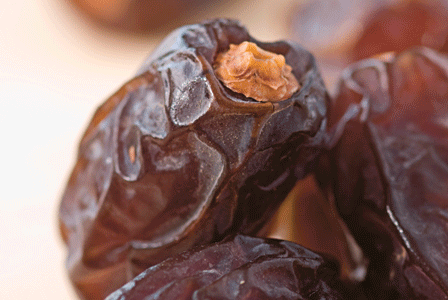
Dried fruit comes to the rescue after fresh local berries and peaches have bid adieu to summer. Our recipes showcase dried fruits nutritious benefits.
Who gives a fig about dried cherries? You should! After the fresh local blueberries and peaches of summer have bid adieu, it’s time to consider their nutritious dried counterparts.
The many guises of dried fruit are sweet packages of nutrition, as removing water from fresh fruit not only concentrates the flavours, but also many of the vitamins, minerals, and disease-fighting antioxidants.
The case for dried
Ounce for ounce, dried figs pack in five times more bone-building calcium and more than twice the amount of blood-pressure-lowering potassium as fresh versions. Prunes have 10 times more vitamin K than the fresh plums they originate from, while dried apricots have three times as much fibre and nearly twice the antioxidant beta carotene of their waterlogged counterparts.
Since high amounts of sugar ward off bacteria, dried fruit can last a year or more in your pantry. On top of familiar choices such as dates, raisins, and apricots, you can now stock up on dried blueberries, mulberries, Incan golden berries, kiwi, goji berries, mango, and other luminous offerings for lunch bags or to gussy up granola, baked goods, salads, stews, and seafood.
The case for caution
Despite all their inherent benefits, keep in mind these caveats. Because dried fruits have less water than fresh, they also have higher proportions of sugar and calories, meaning those watching their waistlines or who are concerned about diabetes need to practice portion control.
Some dried fruits are sweetened further with added sugars, so choose unsweetened versions when possible. Try to avoid sulphites; look for dried organic fruits that are not treated with this preservative.
Crunch bunch
You may have noticed more stores carrying freeze-dried fruits and vegetables. In general, the freeze-drying process involves quickly freezing fruits and vegetables and then vacuuming out air to extract their water. This produces a shelf-stable, crunchy product with the nutrients and flavour intact.
Enjoy them out of hand or mixed into cereal, trail mix, and salads. Try incorporating freeze-dried powders such as acai and pomegranate into baked goods, yogourt, smoothies, and pancake batters. A 2010 study by scientists at Oklahoma State University reported that consuming antioxidant-laden freeze-dried strawberry powder for two months reduced cholesterol numbers in subjects.
Sack the fat
Making use of dried fruit purée in baking lets you cut back on the amount of sugar and fat needed. To make your own:
- Place 1 cup (250 mL) dried fruit, such as dates or apricots, in a bowl and cover with water. Let soak for a couple of hours.
- Drain moistened dried fruit and purée in a food processor. This will make about 1 cup pur?
- Start by replacing half the sugar and fat such as oil or butter a recipe calls for with the purée and see if the results are to your liking.
One sweet package
These compounds make dried fruit champions for health.
|
Dried fruit |
A good source of: |
Health boost |
|
Apricots, |
Beta carotene |
Converted to vitamin A, which contributes to healthy eyes and immune system |
|
Blueberries |
Flavonoids |
Appear to improve brain function |
|
Goji berries |
Polysaccharides |
May inhibit cancer tumour growth |
|
Tart cherries, |
Anthocyanins |
Reduces inflammation and oxidative stress in the body |
| Kiwis | Vitamin C |
Used to make collagen, an important protein for skin, tendons, ligaments, and blood vessels |
| Dates, apples |
Fibre |
Helps quell hunger to reduce overeating |
|
Figs |
Calcium |
Builds stronger bones and may aid in weight loss |
|
Prunes, |
Vitamin K |
Increased intake may reduce type 2 diabetes risk |
|
Raisins, |
Potassium | Keeps blood pressure numbers in check |
Recipes
- Hazelnut Hemp Pancakes with Dried Blueberry Sauce
- Chickpea Goji Berry Salad
- Chocolate Fruit Bark
DIY dried fruit
By making your own dried fruit, you’ll know exactly what you’re eating. One of the best ways to do so is with a food dehydrator, but you can also use your trusty oven. Here’s how.
Step 1: Choose only fully ripened, unblemished fruit. As a rule of thumb, you should get about 1 lb (450 g) of dried fruit for every 5 lb (2.5 kg) of fresh used. Some fruits, such as pineapple, pears, peaches, kiwi, and bananas, should be peeled first.
Step 2: Dip light-coloured fruits such as apricots, apples, bananas, and peaches in lemon juice prior to drying to prevent them from turning dark brown. Remove all cores, stems, and pits. Cut fruit into uniform sizes, keeping in mind the thicker the slices, the longer the drying process.
Step 3: Place prepared fruit in single layers on parchment-lined baking sheets. Cook at your oven’s lowest setting until the fruit has lost its moisture and has become leathery, 2 or more hours. Stir the fruit each hour or so and rotate the baking sheet at least once. Leaving the oven door ajar 1 to 2 in (2.5 to 5 cm) helps keep the air circulating.
Step 4: Let fruit cool completely before storing in an airtight container. For prolonged storage, you can place dried fruit in the freezer.

